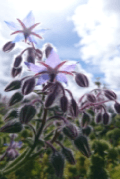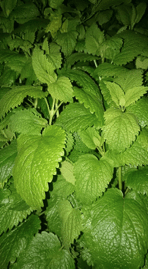In the herbal clinic we use many different plant parts in our preparations. For example, we can use the leaves, seeds or roots to name a few. Certain plant parts are known to have constituents which act on particular body systems more potently than other parts of the same plant. Traditionally, certain parts have been more commonly used and experience has shown particular parts to be more effective than others. However, over time and as new research or experiences emerge, different parts of the same plant may become more popular for new and varied uses.
A good example of a herb that we use various parts of is the stinging nettle (Urtica dioica), used to treat a wide range of conditions. The leaves are used most frequently by herbalists as they are nutritive, antihistamine, anti-inflammatory, diuretic, detoxifying to the blood and kidneys and can prevent loss of iron in heavy bleeding. The root is used more specifically for inflammation and enlargement of the prostate gland where it has a strong anti-inflammatory action. The seeds have been used in modern herbalism for enhancing physical and mental endurance and for treating various diseases of the kidney.
Herbalism is a vast and expansive field with many different outlooks and opinions – there isn’t a straight black and white rule for each herb and often our preferences as herbalists come from our own personal experiences as well as from the other herbalists we admire or have been taught by.
Different plant parts have to be prepared in various ways to extract the optimum level of active constituents and to increase their healing potential. The part used can also depend on the season and what is available for harvest at that time. Here are some examples and ways we can use the various parts as medicines.
Flowers – Common flowers used in the herbal clinic are chamomile, rose, marigold, lime tree flowers, elder, and hawthorn. Flowers should be gathered just before they are fully developed when the scent is most lively on a dry morning. They should not be washed as this will remove the pollen or potentially damage the delicate flower. They can then be dried and used in herbal infusions or can be transferred into a carrier oil or alcohol to make an infused oil or tincture. Infused oils can then be made into ointments and creams to be used topically. Flowers can be distilled to extract their essential oils which are very concentrated and potent. These can be used in topical preparations, for massage or for inhalation. In the clinic we also use flower essences which can be added to our tinctures and are used to treat emotional ailments more specifically. In herbs like rose, chamomile and marigold, the flower is almost exclusively the only part of the plant that is used.

Borage (Borago officinalis)
Leaves and Aerial parts – Usually leaves are best harvested in early or mid – summer when chlorophyll and aromatic medicinal constituents are at their peak. Again, with the leaves of herbs we would dry and potentially tincture them in the same way as flowers. As the leaves of plants are often quite delicate and are easy to break up, they lend themselves well to infusing for tea fresh or dried. There are so many leaves and aerials we use in the clinic. Herbs like hawthorn, marshmallow and dandelion leaves are used as well as their berries, roots and flowers. Herbs such as rosemary, thyme and sage are rich in essential oils and are evergreen so can be used throughout the year – the aerial part of these plants are the only parts used in herbal medicine but they can be distilled for essential oil, drunk in tea, infused in alcohol for tincture and in carrier oil for infused oils. All these methods of medicine making extract their essential oils.
 Lemon balm (Melissa officinalis)
Lemon balm (Melissa officinalis)
Seeds and Fruits – Gathered in the autumn ideally before the weather turns wet. There are some herbs that we use in clinic where the seed is the only part used such as fennel, celery and milk thistle. With fennel the active constituents are more concentrated in the seed than in the aerial parts. Fruits that we use such as elder, bramble, rosehip sea buckthorn and hawthorn are generally very rich in antioxidants, vitamins and minerals and these fruits lend themselves well to being made into syrups to be used throughout the winter to fight off infections and enhance the immune system.
Roots – Roots are also gathered in the autumn going into winter when the aerial part of the plant has died down. With some plants like dandelion it is beneficial to dig up the roots in early spring before they get too woody. The vitality from the upper part of the plant has sunk down into its roots and it is best to dig them up early in the morning or late in the afternoon when sap is rising and falling. There are different requirements for various plants but with most roots its best to cut them whilst they are fresh to make them easier to manage as they become very hard when dry. They can then be dried and ground to a powder or they can be gently simmered (decocted) in water to extract the active constituents. Well chopped roots can be added to alcohol to make tinctures or can be very slowly heated over several hours in a carrier oil to make an oil infusion – Comfrey being a good example here. With certain plants like burdock, yellow dock, echinacea and valerian; the root is the only part we use.
Bark – Bark should be collected in the autumn when the sap of the tree is falling or in the early spring when rising. Its very important not to cut bark off round the circumference of the tree as this will kill it and is better to use lengthwise cuts (one quarter or less of the circumference) of branches or smaller twigs if possible. Bark can be used in a similar way as roots, chopping first before drying. In the clinic we use trees like willow, oak, birch and alder to treat various conditions.
In my own experiences of making tinctures I have discovered that using the whole plant creates a very complete and well-rounded medicine in terms of taste and effect. This makes me think of holistic medicine in that the whole is greater than the sum of its parts and the importance of not thinking reductively about health and maybe about herbs too. Its important to harvest herbs responsibly and ecologically, taking only what you need. Some plants are endangered and you can’t harvest them from the wild. Some parts of the plant may be poisonous whilst others are safe to use. Ensure you have identified the plant you are harvesting correctly before collecting and using.
